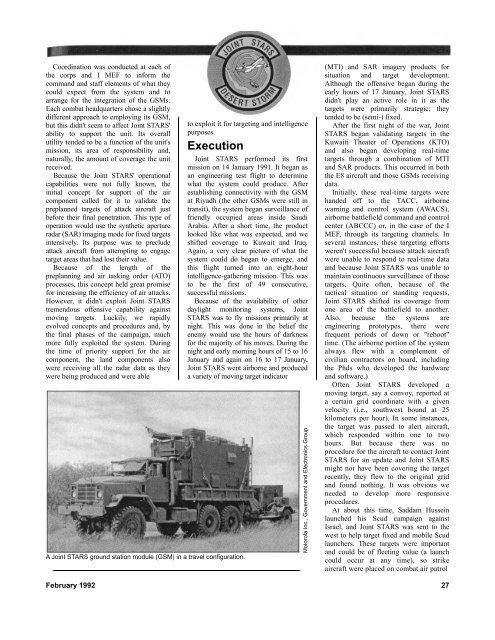February - Fort Sill - U.S. Army
February - Fort Sill - U.S. Army
February - Fort Sill - U.S. Army
You also want an ePaper? Increase the reach of your titles
YUMPU automatically turns print PDFs into web optimized ePapers that Google loves.
Coordination was conducted at each of<br />
the corps and I MEF to inform the<br />
command and staff elements of what they<br />
could expect from the system and to<br />
arrange for the integration of the GSMs.<br />
Each combat headquarters chose a slightly<br />
different approach to employing its GSM,<br />
but this didn't seem to affect Joint STARS'<br />
ability to support the unit. Its overall<br />
utility tended to be a function of the unit's<br />
mission, its area of responsibility and,<br />
naturally, the amount of coverage the unit<br />
received.<br />
Because the Joint STARS' operational<br />
capabilities were not fully known, the<br />
initial concept for support of the air<br />
component called for it to validate the<br />
preplanned targets of attack aircraft just<br />
before their final penetration. This type of<br />
operation would use the synthetic aperture<br />
radar (SAR) imaging mode for fixed targets<br />
intensively. Its purpose was to preclude<br />
attack aircraft from attempting to engage<br />
target areas that had lost their value.<br />
Because of the length of the<br />
preplanning and air tasking order (ATO)<br />
processes, this concept held great promise<br />
for increasing the efficiency of air attacks.<br />
However, it didn't exploit Joint STARS<br />
tremendous offensive capability against<br />
moving targets. Luckily, we rapidly<br />
evolved concepts and procedures and, by<br />
the final phases of the campaign, much<br />
more fully exploited the system. During<br />
the time of priority support for the air<br />
component, the land components also<br />
were receiving all the radar data as they<br />
were being produced and were able<br />
A Joint STARS ground station module (GSM) in a travel configuration.<br />
to exploit it for targeting and intelligence<br />
purposes.<br />
Execution<br />
Joint STARS performed its first<br />
mission on 14 January 1991. It began as<br />
an engineering test flight to determine<br />
what the system could produce. After<br />
establishing connectivity with the GSM<br />
at Riyadh (the other GSMs were still in<br />
transit), the system began surveillance of<br />
friendly occupied areas inside Saudi<br />
Arabia. After a short time, the product<br />
looked like what was expected, and we<br />
shifted coverage to Kuwait and Iraq.<br />
Again, a very clear picture of what the<br />
system could do began to emerge, and<br />
this flight turned into an eight-hour<br />
intelligence-gathering mission. This was<br />
to be the first of 49 consecutive,<br />
successful missions.<br />
Because of the availability of other<br />
daylight monitoring systems, Joint<br />
STARS was to fly missions primarily at<br />
night. This was done in the belief the<br />
enemy would use the hours of darkness<br />
for the majority of his moves. During the<br />
night and early morning hours of 15 to 16<br />
January and again on 16 to 17 January,<br />
Joint STARS went airborne and produced<br />
a variety of moving target indicator<br />
Motorola Inc., Government and Electronics Group<br />
(MTI) and SAR imagery products for<br />
situation and target development.<br />
Although the offensive began during the<br />
early hours of 17 January, Joint STARS<br />
didn't play an active role in it as the<br />
targets were primarily strategic; they<br />
tended to be (semi-) fixed.<br />
After the first night of the war, Joint<br />
STARS began validating targets in the<br />
Kuwaiti Theater of Operations (KTO)<br />
and also began developing real-time<br />
targets through a combination of MTI<br />
and SAR products. This occurred in both<br />
the E8 aircraft and those GSMs receiving<br />
data.<br />
Initially, these real-time targets were<br />
handed off to the TACC, airborne<br />
warning and control system (AWACS),<br />
airborne battlefield command and control<br />
center (ABCCC) or, in the case of the I<br />
MEF, through its targeting channels. In<br />
several instances, these targeting efforts<br />
weren't successful because attack aircraft<br />
were unable to respond to real-time data<br />
and because Joint STARS was unable to<br />
maintain continuous surveillance of those<br />
targets. Quite often, because of the<br />
tactical situation or standing requests,<br />
Joint STARS shifted its coverage from<br />
one area of the battlefield to another.<br />
Also, because the systems are<br />
engineering prototypes, there were<br />
frequent periods of down or "reboot"<br />
time. (The airborne portion of the system<br />
always flew with a complement of<br />
civilian contractors on board, including<br />
the Phds who developed the hardware<br />
and software.)<br />
Often Joint STARS developed a<br />
moving target, say a convoy, reported at<br />
a certain grid coordinate with a given<br />
velocity (i.e., southwest bound at 25<br />
kilometers per hour). In some instances,<br />
the target was passed to alert aircraft,<br />
which responded within one to two<br />
hours. But because there was no<br />
procedure for the aircraft to contact Joint<br />
STARS for an update and Joint STARS<br />
might not have been covering the target<br />
recently, they flew to the original grid<br />
and found nothing. It was obvious we<br />
needed to develop more responsive<br />
procedures.<br />
At about this time, Saddam Hussein<br />
launched his Scud campaign against<br />
Israel, and Joint STARS was sent to the<br />
west to help target fixed and mobile Scud<br />
launchers. These targets were important<br />
and could be of fleeting value (a launch<br />
could occur at any time), so strike<br />
aircraft were placed on combat air patrol<br />
<strong>February</strong> 1992 27
















